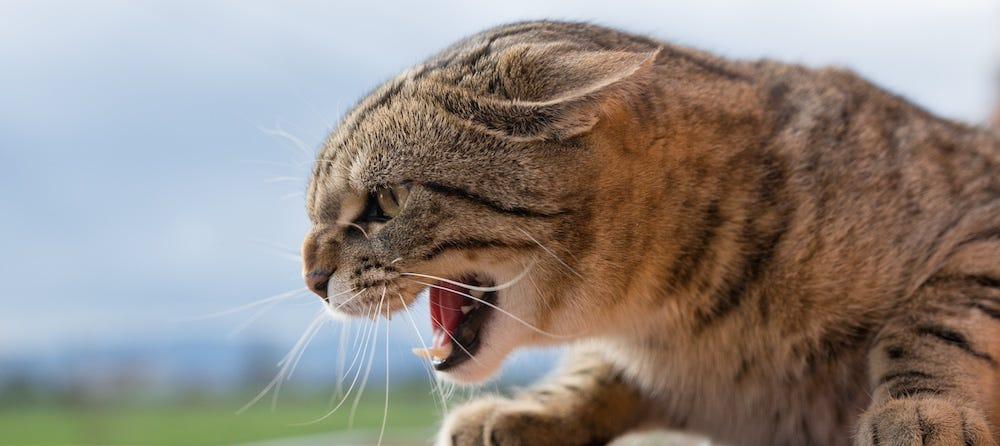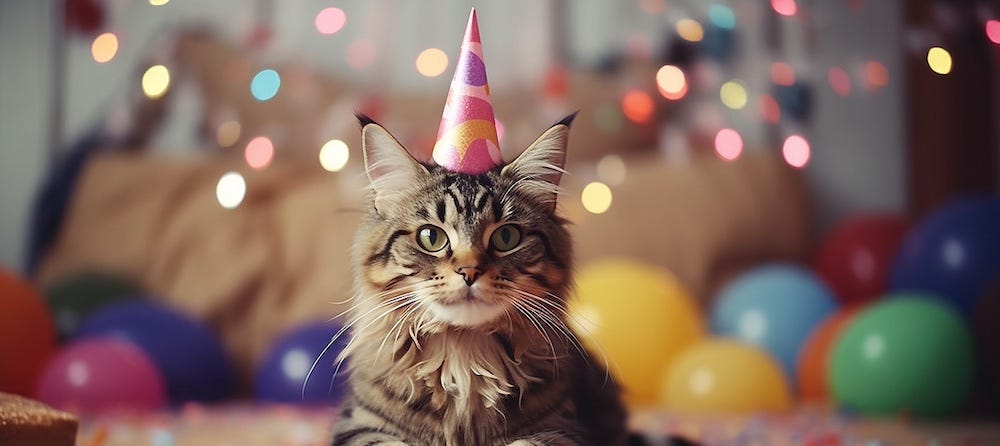Choosing to live a more eco-friendly lifestyle means we have to make better choices for ourselves and our pets.
It’s easy to go through life not paying much attention to our impact on the environment, tossing out a whole tray of litter, or buying your pet another toy without a second thought. To live as a more conscious pet parent, we have to consider the ways we care for our pets. Everything from feeding and accessorizing to waste management has an environmental impact. Here are some easy ways to reduce your carbon footprint with cats.
What is a carbon footprint?
In short, a carbon footprint is the mark that humans (and in this case, cats) leave on the environment. This could be the actions of an individual, a family, an organization, or an event. It measures the total amount of greenhouse gas (GHG) emissions associated with human activity over a certain amount of time. There is a carbon footprint for just about everything: cat toys, your car, clothing, and food production.
The rapid increase of greenhouse gasses being released into our atmosphere by human activity and consumption is a direct contribution to global warming. The bigger the carbon footprint, the greater the cumulative contribution to climate change.
How do I calculate carbon footprint?
The best way to know what kind of impact your daily actions have on your carbon footprint is to use a calculator like this one. Add up how much you’re spending on things like electricity and food to get an idea of how it’s affecting the environment.
Don’t forget to include how much you’re spending on your cat’s food and the manufactured products you buy for them like bowls, toys, litter, and any accessories.
According to the book “How Bad Are Bananas?” by Mike Berners-Lee entertainment, an average-sized cat has a carbon footprint of 310kg of CO2e per year. Just in eating habits alone, UCLA professor Gregory Okin states that cats are responsible for releasing as much as 64 million tons of greenhouse gasses per year. That’s the rough equivalent of driving over 13 million cars.
Tips for offsetting your cat’s carbon footprint
So, how can pets reduce their carbon footprint? With a little conscious effort on your part, your cat can reduce their carbon footprint in many different areas. Let’s take a look at the different ways you can take an eco-conscious route when caring for your pets.
Cat food
Switching your cat’s food to a more eco-friendly option will make one of the biggest impacts on lowering their carbon footprint. Certain flavors of cat food require more resources to produce than others. Here is what to consider when it comes to your cat’s diet.
Sustainable cat food
Cat food contains 30 to 60 percent animal protein, and meat is a very energy-intensive food ingredient that requires large amounts of fossil fuels, water, and land to produce. It is one of the leading causes of water pollution and biodiversity loss. Even non-meat ingredients create pollution through fertilizers and pesticides, making your cat’s food a large source of greenhouse gas emissions.
The machines and materials used to produce and package the food, as well as the trucks and handling methods used to distribute the food, all require significant amounts of resources and energy. Fossil fuels result in significant carbon pollution.
Buy organic: Livestock farming contributes to the destruction of forest ecosystems. Look for food that was sourced from farms where animals had the ability to move freely versus factory farms. Pesticides and hormones used in non-organic food also heavily contribute to climate change.
Avoid beef: A pound of beef takes considerably more land and water to produce than a pound of chicken. Opt for chicken or fish instead of beef.
Packaging: Look for brands that use biodegradable, post-consumer recycled packaging, or no packaging at all. Plastic sits in landfills for decades or longer and spreads harmful toxins. Oftentimes, we buy food and pour it into a food bin, immediately discarding the packaging. If possible, bring a reusable bag and buy in bulk to keep the packaging out of landfills.
Correct serving size: Pay attention to the amount of food your cat actually needs. Check the package for the recommended serving for your cat’s weight, age, and activity level. Then, measure out the amount you're giving them at feeding time. (An automatic pet feeder can make this job much easier!) Pet parents often feed their pets 2-3 times the amount of protein they actually need for a healthy diet.
Buy local: When you buy local, you’re helping to preserve small farmlands and reduce the number of fossil fuels required to ship and transport food. Plus, you’re contributing to the local economy!
Make your own cat treats
Making your own cat treats is another great way to help reduce your carbon footprint—and it’s super easy! Here’s how:
Ingredients:
- One can tuna in oil, drained
- One egg
- 1 ¼ cups of flour, plus extra for dusting
- ½ cup water
- Bottle cap for cutting out treats
Directions:
- Mix tuna, egg, flour, and water in a food processor until it forms a dough.
- Dust a surface with flour and roll out dough to ½-inch thick.
- With a bottle cap, cut the treats from the dough.
- Bake for 15 minutes at 350℉ on a cookie sheet lined with parchment paper.
- Let cool and serve.
Cat waste
Americans fill landfills with about 2 million tons of cat litter each year. Add that to the mountain of garbage created by producing and using other cat-related items, and our total landfill input is enormous. You can help reduce that waste by switching to high-quality litter.
Try switching to biodegradable pet waste bags instead of disposing of clumps in a plastic bag, which will only extend the time it takes for waste to decompose. Use biodegradable pet waste bags that disintegrate and allow their contents to decompose more quickly.
High-quality litter
Change your litter to a high-quality litter like clay-clumping cat litter formulated for Litter-Robot, which is made of all-natural sodium bentonite that is non-toxic and helps stop the spread of earth-damaging chemicals. Sign up for a subscription today!
Reduce litter consumption
Constantly throwing out litter produces a ton of waste. When you get a self-cleaning litter box like the Litter-Robot 3 Connect, you’ll help reduce how often you throw away litter. A self-cleaning litter box will sift through waste and leave the fresh litter for your cat to use again.
Cat toys
Avoid looking for cat products that just look good, and instead seek products made from sustainable and natural materials. Alongside making your own cat toys and upcycling materials, check out these tips!
Green pet products
You can find a ton of pet products made from sustainable materials, from biodegradable cat toys to bamboo cat beds. Going green helps the environment by reducing the amount of pollution entering the air, soil, and water. Commonly, you can find bowls made from bamboo, leashes made from recycled plastic, and biodegradable waste bags.
DIY pet toys
Making your own cat toys is easier than you think. Cut toilet paper rolls into short tubes for your cat to bat around. Or roll cardboard into a 3 and a half inch roll, secure it with tape, and glue cork to the outside for a cat scratching pad. You could even cut holes in the top of a disposable food container with a utility knife, then fill the container with catnip or toys you already have for a fun cat puzzle. You’d be surprised at how much fun a cat can have with things just laying around the house!
Biodegradable toys and packaging
When you buy biodegradable toys, you’ll know that even when your cat is done with them, they won’t stick around for years to come. Look for items with the least packaging that are natural and made of organically produced materials. Not only will you feel good about the safety of your cat but the earth will feel good too!
Cat Accessories
When it comes to giving your cat a cozy place to hang out and play, look for cat furniture that is high quality and made to last. Check out these top picks!
High-quality pet furniture
Instead of going the cheap route, opt for sustainable furniture (for cats) that is made to last. That way, you won’t need to replace furniture often and can avoid landfill contributions.
Donate or upcycle
Rather than just tossing out old pieces of cat furniture, consider donating them or upcycling them. Your old cat accessories can be reused, given a new purpose, or rehomed. Shelters are always in need of donations—call your local shelter to help!
Cat health
Keeping your pet healthy is a positive for them and the environment, from vet appointments and medical treatments to supportive care products. Use these 3 ways to reduce your carbon footprint.
Dispose of pet chemicals responsibly
Always take the proper steps to discard pet medications such as flea control products, shampoos, and other medications. Never flush pet medications down the toilet! This can contaminate our water and harm plant and animal life.
The best way to dispose of pet medications is to take the medication out of the original container and eliminate identifying information on the label. Identify if the container is made out of recyclable material and appropriately dispose of it. Next, visit the Drug Enforcement Agency’s Controlled Substance Public Disposal Location page and find the nearest location to properly dispose of the medication.
Skip chemicals and toxins
Go the non-toxic route with oral care, shampoo, and cleaning supplies. Cats can absorb toxins in chemical-based products just like humans can, so it’s important to choose environmentally-friendly, non-toxic products to keep your cat safe and healthy.
- Treat your cat's oral care needs with non-toxic products. Putting the product directly into their mouths means they are more likely to ingest it.
- Look for shampoos that are non-toxic as well. Cats can not only absorb the chemicals through their skin but through grooming themselves. If their fur is covered in chemicals, they’ll be directly ingesting the toxins.
- Use enzyme-based cleaners around your house and when cleaning your litter box. Cats are sensitive to fragrance as well, so it's best to use fragrance-free cleaners.
Spay or neuter your pet
It's estimated that the number of homeless pets is nearly 70 million. Help reduce the number of unwanted pets by getting them spayed or neutered. You’ll also be helping to protect against serious health issues and the spread of disease among homeless pets. Contact your vet or find a local animal shelter to spay or neuter your pets at an affordable price.
Additional eco-friendly tips
You can help make a positive impact on the environment and encourage businesses to operate in a more eco-friendly way by putting your money where it matters.
Buy voluntary carbon offsets
Offset your carbon footprint by voluntarily buying carbon offsets from non-profit companies like CoolEffect, which put 90% of their donation towards projects that benefit the environment. Carbon offsets help to reduce emissions of carbon dioxide and other GHG.
Support the right companies
Support pet supply companies who have eco-friendly and sustainable products. When you shop for your pet, you're voting with your dollars—and ultimately that will help encourage companies to move towards an eco-friendly business approach.
Reduce your cat’s carbon pawprint with Litter-Robot
Play your part in creating a better world for yourself and generations to come by reducing your household carbon footprint. Focusing on making small changes in how you care for your pet can make a huge difference.
Reduce your carbon footprint even more by using the Litter-Robot 4! This self-cleaning litter box sifts through the litter to dispose of waste and keep litter fresh. Not only will you not have to change litter as often, you can save money by not having to buy as much litter.




